- Student
- Amanda Buerger
- College(s)
- College of Science
- Faculty Advisor
- Jason McLachlan & Barbara Hellenthal
- Class Year
- 2015
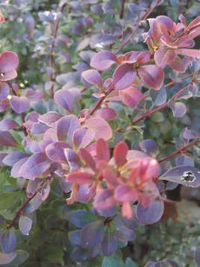
Non-native species are often introduced into new areas through human means, whether intentionally or unintentionally; some of these species become problematic in these new locations (Davis 2009). Given the history of the University of Notre Dame, many non-native plant species were brought to the campus by priests and brothers from Europe (Schlereth 1976). While many of these non-native species are not invasive, the Indiana Invasive Species Council has listed some of the plants found on campus as invasive (2012). The goal of this project is to identify invasive plants on Notre Dame’s campus, evaluate the reasons for invasiveness of each plant, create a draft policy document for the prohibition of planting of certain invasive plants and to suggest alternative species for each one, and finally to provide feedback to the Indiana Invasive Species Council.
Notre Dame Plant History
The University of Notre Dame was founded in 1842 by Father Edward Sorin, and grew to include priests and brothers from all over the world (Schlereth 1976). However, before their arrival, the landscape (trees, shrubs, land features) was recorded in the United States government-employed land surveyor notes (McIntosh 1993). Based on these notes, the land that would eventually become home to the University of Notre Dame was rather swampy in places, and forested, containing many species of native oaks, ash, cherry, cedar, elm, hickory, maple, sycamore and walnut trees, as well a few notable shrub species including hazel, pawpaw and spice bush (McIntosh1993).
The first major changes to the flora at Notre Dame occurred shortly after the founding of the university in the form of 10 acres of agricultural lands; wheat, potatoes and corn were among the first crops planted at Notre Dame, and livestock also grazed on the land (Schlereth 1976). Additionally, orchards and trees were added to the landscape of Notre Dame early in its history, marking further changes in the flora (McIntosh 1993). The main quadrangle of campus, located south of the Main building, became an arboretum with formal gardens, statues and fountains (Schlereth 1976). The European species on the Main Quadrangle are evidence of the involvement of Brother Peter Fitzpatrick, who was inspired by French Renaissance plantings, and Brother Philip Kunze, who planted 50 species of trees in the arboretum during his 60-year task of landscaping the entire campus with over 306 species (Schlereth 1976).
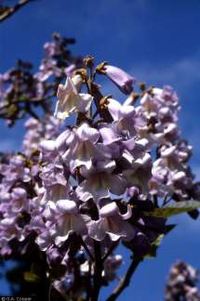
The main quadrangle still boasts many woody species as it did during Brothers Fitzpatrick and Kunze’s work, as listed by Barbara Hellenthal following her campus survey (1993). In this survey, she and some students worked to identify every plant on campus; the book contains descriptions and locations of each species (Hellenthal 1993), some of which are still on campus today. This provides a snapshot of the campus 150 years after its founding, a documentation of the campus flora at that moment, which included hundreds of species and cultivars of trees, shrubs, vines and flowers. The recorded locations of members of a certain species in the 1993 survey were verified as still accurate today, providing reference specimens for the identification of other plants of the same species during this current survey of Notre Dame’s campus. Today, the flora of Notre Dame has somewhat changed since Barbara Hellenthal’s survey as some of the plants she observed are no longer on campus while others not listed in the book are now present, especially given the new buildings and construction on campus.
Future expansion of the university will require new plantings and modifications of existing ones, which the university intends to retain in the traditional Roman-style (Affleck-Graves et al. 2008). Furthermore, the plan asserts that there will be stewardship for “the natural environment”, although the specifics of the exact meaning of this term are not discussed (Affleck-Graves et al. 2008). However, this provides evidence that landscaping still plays a vital role in the campus planning, marking the importance of plants to the history and current state of the University of Notre Dame. Interestingly, landscaping is so valued at Notre Dame that the Sustainability website includes a tree tour of campus; however this tour includes invasive trees, but does not mention their invasiveness, which may lead viewers of the tour to appreciate the trees, contributing to further planting and spreading of these trees (Sustainability 2014). Lastly, there is a list of plants not to be planted on campus in the ‘Basis of Design and Reference Guide and Minimum Specifications Requirements’ for Notre Dame; but, the reasons for not planting these species may or may not be related to invasiveness (University of Notre Dame 2013). Regardless, there is evidence of the importance of landscaping in both the past and present on the campus of the University of Notre Dame.
Invasiveness and Impacts
An understanding of the properties of invasive plant species is necessary in order to construct the best argument against the use of these plants on the campus of the University of Notre Dame. Generally, an invasive plant is one that establishes outside of its native range, resulting consequences such as monetary and biological damage (United States Department of Agriculture 2009). Some specific evidence for the damage caused by invasive plant includes the ability of invasive weeds to lead to declines in native flora, often though the introduction of biological control methods that inadvertently target the native species; additionally, competition between the invasive species and native species may also lead to declines in the native flora (Rand and Louda 2004).
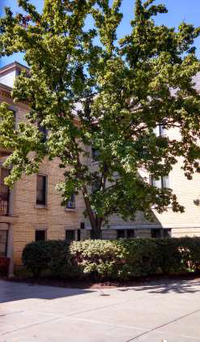
While these general properties can aid in the determination of invasiveness, there are many characteristics of any species that contribute to its invasive potential (Indiana Invasive Species Council 2012). Some of these important characteristics include the ability of the species to invade into the area in question, the challenges the species faces in invading the area, the impacts of the invasion on the ecosystem and environment as well as the economic impacts observed, and the methods of controlling or managing the species if possible (Davis 2009). Overall, the United States government has estimated that billions of dollars are lost each year due to economic and environmental harm caused by invasive plants, including loss of agricultural yields (Livingston and Osteen 2008). Additionally, there are 21 federal agencies that have responsibilities influenced by the presence of invasive species (Livingston and Osteen 2008). In order to prevent further costs, this document suggests that preventing the introduction of invasive species, instead of managing them once present, is the most economically and resource feasible option (Livingston and Osteen 2008).
Species on the IISC list have been documented to have consequences consistent with the invasive properties previously discussed. In Chicago, common buckthorn was targeted for eradication during the autumn season because its leaves do not change as quickly as the native species, as it did not evolve in the area (Botts 2014). Such eradication included several herbicide treatments and mechanical removal techniques, which can be expensive and labor intensive (Botts 2014). Another group of shrubs, the honeysuckles, have also caused problems for areas near Notre Dame. In particular, the invasive shrubs have dominated a creek that flows through two parks in Fort Wayne, Indiana by shading out the native shrubs in the area for four years (South Bend Tribune 2014). Due to these circumstances, volunteers spent four days attempting to remove the bushes (South Bend Tribune 2014). Another invasive shrub, glossy buckthorn, also has negative ecosystem consequences. In forests, it colonizes gaps in the canopy, out competing many native trees, and ultimately leading to changes in forest tree composition (Fagan and Peart 2004).
While Notre Dame is not a forest community, escapees, such as those seen around the lakes at Notre Dame, are likely to colonize local forests. Not only can invasive shrubs cause problems for ecosystems, but also invasive trees have the same potential. For example, Norway maple has been found to reduce North American forest biomass by up to 23.5%; this is likely due to Norway maple shading out the native maple plants, leading to a reduction in seedling growth and a change in canopy composition (Fang and Wang 2011). Tree-of-heaven is also rather invasive; it forms very large monospecific stands of trees and was found in over 50% of 1.6km sample areas along Virginian highways (McAvoy et al. 2012). In Baltimore, cases of property values declining due to the presence of invasive trees that grow back after being cut down, such as the Princess Tree, are common (Scharper 2014).
Economic problems may also result from the presence of English ivy, an invasive vine, and it should therefore be avoided on Notre Dame’s campus. English Ivy can actually cause structural damage, especially to buildings with pre-existing cracks and voids; however it can also protect buildings against temperature changes and moisture (Viles et al. 2014). The study recommends appraisals to determine whether ivy is likely to cause problems (Viles et al. 2014); however, these appraisals mark an additional cost associated with the presence of the vine.
Invasive Plant Policy
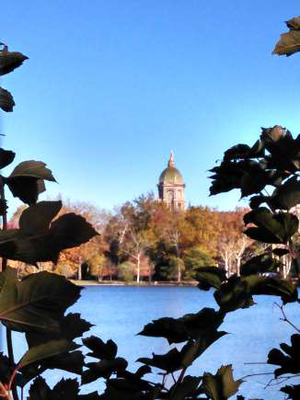
While Notre Dame does not have an invasive plant policy, it does have a list of plants to be avoided in landscaping, although not necessarily as a result of invasiveness. The Basis of Design Reference Guide and Minimum Specification Requirements policy at the University of Notre Dame outlines the building requirements for new construction on the campus (University of Notre Dame 2013). Of the 21 woody species that Notre Dame states ‘should be avoided’ from use in landscaping, Vinca minor and any type of ivy (which includes English Ivy, Hedera helix) are the only species also on the IISC list (University of Notre Dame 2013). This is significant because the two species on Notre Dame’s list may be included not due to their invasiveness, but because of other problems associated with each species.
Also of interest in the “Tree Removal Permit” for Notre Dame’s campus (University of Notre Dame 2013). Information including location, project, number of trees to be removed, reason for removal, and number of replacement trees are required to be listed (University of Notre Dame 2013). An interesting aspect of the form is the requirement of three separate individuals to approve the removal of a tree (University of Notre Dame 2013). This indicates that there may be difficulties in removing invasive trees currently on campus, as three people will need to agree on the removal.
Invasive plant policies have been adopted by several colleges throughout the United States. At Humboldt University in California, a student project determined which species on the campus are invasive, as well as indicated which areas of campus contain these species, goals similar to some of those in this Notre Dame project (Haynes et al. 2013). While students at Humboldt University provided a project similar to the one in progress at Notre Dame, it did not produce a policy document adopted by the university. However, Green Mountain College in Vermont did adopt an official invasive species policy document to be followed by the landscaping department in which the plan for monitoring the invasive species was mentioned, although specifics were not included; instead it was agreed that the species would be checked only periodically (Public Policy 2005). Through this policy, nonnative plant species that persist outside of cultivation can be removed via mechanical, biological or chemical control methods, and native plants must be used when restoring the previously inhabited area (Public Policy 2005).
The policy adopted at the University of Central Florida calls for removal of already-present invasive species, and the limitation on planting of further invasive species, in addition to other goals such as creating a secure and comfortable environment (University of Central Florida 2015). Haywood Community College strictly prohibits the planting of invasive species in order to protect the natural ecosystems near campus (Haywood Community College 2015). Similarly, Saint John’s University firmly limits the use of invasive plants and briefly outlines procedures for new plantings in order to achieve this goal (Saint John’s University 2010). Within the “Campus Management Plan”, the University of Michigan outlines its stance on invasive plants-namely that invasive species cause biological damage, so the removal of such species, especially from walking trails, is encouraged (University of Michigan 2011). While most these policies are more extensive than the one presented to Notre Dame, and which often include great procedural detail that is not yet necessary at Notre Dame, the success of such strenuous policies encourages the success of a less stringent, more goal focused rather than rule focused policy at Notre Dame.
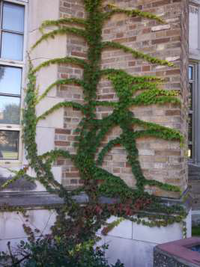
As a project incorporating scientific research and observation with historical perspectives and policy design, this project is innately multidisciplinary. Understanding the biological basis of invasive species, the problems associated with the specific species of interest, the history of flora at the University of Notre Dame, the problems with invasive species at other universities and the policy documents produced at these universities will provide the necessary information to create a policy at Notre Dame aimed at reducing the number of invasive species planted on the campus. The adoption of such an act will provide an example to the community and visitors of Notre Dame, and hopefully encourage these and other people to stop planting invasive species in their own yards.




